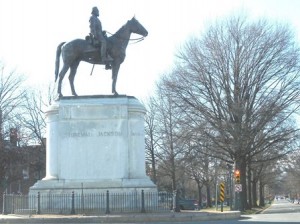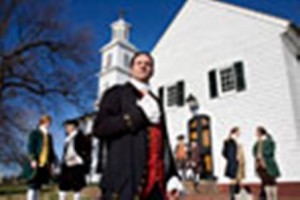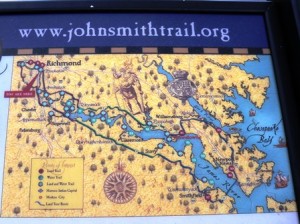» posted on Saturday, March 9th, 2013 by Linda Lou Burton
Trailing History
 Linda Burton posting from Richmond, Virginia – I need to put my waders on. History is knee-deep here in Richmond, and then some; it is layered and twined with life as it goes on today. Every downtown street and hill top and river bottom is slathered with the taste of it; first-graders on a yellow bus circle Stonewall Jackson’s statue on the way to school. Sunday skateboarders veer down Bank Street, just below the pristine white-columned capitol, first used in 1792, French-inspired, Thomas Jefferson designed. A man walks his red-collared dog in Great Shiplock Park, they stroll the edge of James River on this side of Manchester Docks, where
Linda Burton posting from Richmond, Virginia – I need to put my waders on. History is knee-deep here in Richmond, and then some; it is layered and twined with life as it goes on today. Every downtown street and hill top and river bottom is slathered with the taste of it; first-graders on a yellow bus circle Stonewall Jackson’s statue on the way to school. Sunday skateboarders veer down Bank Street, just below the pristine white-columned capitol, first used in 1792, French-inspired, Thomas Jefferson designed. A man walks his red-collared dog in Great Shiplock Park, they stroll the edge of James River on this side of Manchester Docks, where  slaves once arrived from Africa. Across the street condo dwellers live in downtown luxury, it’s the reconverted buildings of Tobacco Row where Lucky Strike is bricked into the factory’s chimney, left behind as a historic masterpiece. Suburban dwellers cross Lee Bridge and head home on J D Hway, that’s Robert E Lee and Jefferson Davis, you know; the road is dotted with historic markers directing you to battle sites. Steven Spielberg filmed the movie Lincoln here; no city is more central to the Civil War. But go back farther than that; think John Smith, and Pocahontas, and the Jamestown settlement just downstream. Think
slaves once arrived from Africa. Across the street condo dwellers live in downtown luxury, it’s the reconverted buildings of Tobacco Row where Lucky Strike is bricked into the factory’s chimney, left behind as a historic masterpiece. Suburban dwellers cross Lee Bridge and head home on J D Hway, that’s Robert E Lee and Jefferson Davis, you know; the road is dotted with historic markers directing you to battle sites. Steven Spielberg filmed the movie Lincoln here; no city is more central to the Civil War. But go back farther than that; think John Smith, and Pocahontas, and the Jamestown settlement just downstream. Think  Revolution, and Patrick Henry, whose famous words rang out in St John’s Church on East Broad; “Give me liberty, or give me death.” It’s more than I can wade through in two weeks; I’m dividing the organized trails into groups for exploring, to get at least an overview; early European settlement days; Revolutionary War; and Civil War. Put on your boots and follow me.
Revolution, and Patrick Henry, whose famous words rang out in St John’s Church on East Broad; “Give me liberty, or give me death.” It’s more than I can wade through in two weeks; I’m dividing the organized trails into groups for exploring, to get at least an overview; early European settlement days; Revolutionary War; and Civil War. Put on your boots and follow me.
Let’s go back to 1606. That’s when King James granted a charter to the Virginia Company of London enabling private investors to establish a colony in North America. When Capt John Smith and 100 male colonists arrived that winter the native Algonquian  population was somewhere between thirteen and twenty thousand, settled mostly along rivers where marshes supplied rice, and roots. They grew crops of corn and squash and other vegetables; the men were skilled hunters and fishermen. The English gentry who first came were not, however; most were unwilling to work; they hoped to find gold or a passage to the Pacific; wealth, not colonization, was their agenda. The next years were times of turmoil before an eventual change of focus; Smith was imprisoned by his own people and later by Algonquian Chief Powhatan over various issues before the settlement became “permanent;” his writings are among the few first-hand accounts of the colony and its Algonquian neighbors.
population was somewhere between thirteen and twenty thousand, settled mostly along rivers where marshes supplied rice, and roots. They grew crops of corn and squash and other vegetables; the men were skilled hunters and fishermen. The English gentry who first came were not, however; most were unwilling to work; they hoped to find gold or a passage to the Pacific; wealth, not colonization, was their agenda. The next years were times of turmoil before an eventual change of focus; Smith was imprisoned by his own people and later by Algonquian Chief Powhatan over various issues before the settlement became “permanent;” his writings are among the few first-hand accounts of the colony and its Algonquian neighbors.
The Virginia Indian Heritage Trail www.virginiahumanities.org/virginia-indian-program is a good resource for understanding the history and culture of the region’s first inhabitants; go to the website for maps of important places. The John Smith Trail www.johnsmithtrail.org allows both boaters and motorists to explore historic sites along the James River from Richmond to Hampton Roads; the nearly forty stops are related to Smith’s voyages from 1607 to 1609.
Fast forward to March 23, 1775. That’s when Patrick Henry gave his “Liberty or Death” speech at St John’s Church in Richmond during the Second Virginia Convention. The church, on East Broad Street, was declared a National Historic Landmark in 1961; a good starting point for trailing the events surrounding the Revolutionary War. The Road to Revolution Trail www.roadtorevolution.org has ten sites central to the life and achievements of Patrick Henry. Points include Rural Plains, one of the region’s oldest homes, where Henry married Sarah Shelton; Pine Slash, the 300-acre tobacco farm bequeathed to Henry as a dowry; and St John’s Church, of course.
Patrick Henry’s name is joined by those of George Washington and Thomas Jefferson; over a hundred colonial leaders met in the church as elected delegates to that Convention, one of five held by the colony of Virginia to organize its protests against Great Britain. Henry’s resolutions passed by a narrow margin but his impassioned plea had national implications; the next month shots were fired at Lexington and Concord; Virginia’s support of independence prevented the American Revolution from becoming a regional conflict. The capital of the colonies was moved from Williamsburg to Richmond April 18, 1780 in hopes of offering it more protection from the British; however it was burned by British troops in 1781. Virginia became the 10th US state on June 25, 1788; keep that factoid in mind as we continue trailing history.
Forward again, to May 1861. Virginia voters ratified Virginia’s secession from the Union; the Confederate capitol was moved from Montgomery to Richmond; Union troops captured Alexandria without a fight; the Union cry was “On to Richmond!” Most battles in the Eastern Theater of the Civil War took place in Virginia; go to www.civilwartrails.org and www.nps.gov/rich for maps and information. The Civil War Gateway Visitor Center is at Historic Tredegar, once the largest munitions factory in the south. The Sites of the Bermuda Hundred Campaign www.chesterfieldhistory.com will guide you through ten Civil War sites linked with one of the most important campaigns of the Civil War.
You can trail four centuries of history along Virginia’s Route 5 on the Jamestown Discovery Trail www.virginia.org/jamestowndiscoverytrail ; it takes you through three of the eight original shires of Virginia (shires = counties). This trail connects three National Park sites, seven National Historic Landmarks and plantations, three county parks, and 37 historic highway markers. It has everything, from 1607 and the beginning of Jamestown through the introduction of Virginia’s plantation economy to the Civil War and the end of slavery.
You’ll see the Richmond National Battlefield Park and you’ll see where General Grant crossed the James River. You can visit Berkeley Plantation, where the first American Thanksgiving was celebrated in 1619 and where two Harrison presidents were born – William Henry (9th) and Benjamin (23rd). You’ll definitely want to see the exhibits and the fort at Jamestown Settlement, plus replicas of the ships that brought the first Jamestown settlers. Adkin’s Store community is home of the Chickahominy Tribal Center, where the annual Chickahominy PowWow takes place. A historic marker along the way commemorates the birthsite of Rev Lott Cary, America’s first African-American missionary, who was born a slave and helped found the Colony of Liberia.
The Richmond Slave Trail www.richmondgov.com/CommissionSlaveTrail stretches from the docks at Manchester, where slaves arrived, to the former marketplace in Shockoe Bottom where slaves were bought and sold. From 1840 to 1865 Richmond was home to the largest domestic slave export business in the US. Over 100,000 Africans were brought to Virginia between the 1600’s and the American Revolution; a statue along the Trail in Richmond is part of the Reconciliation Triangle that includes Liverpool, England and Benin, West Africa.
Like I said, this area is knee-deep in history.
